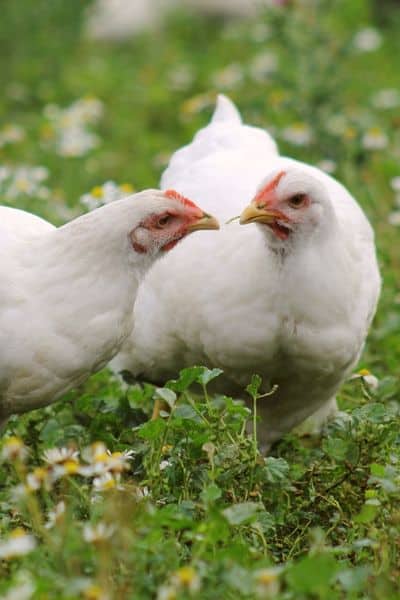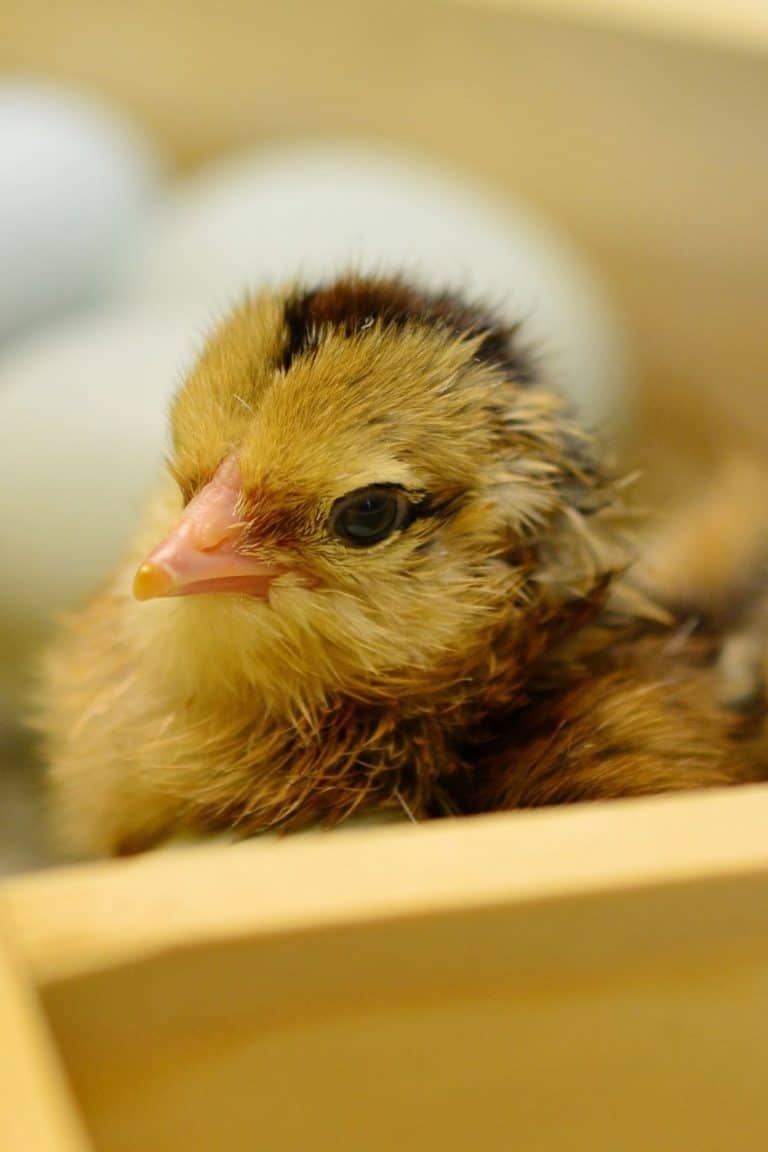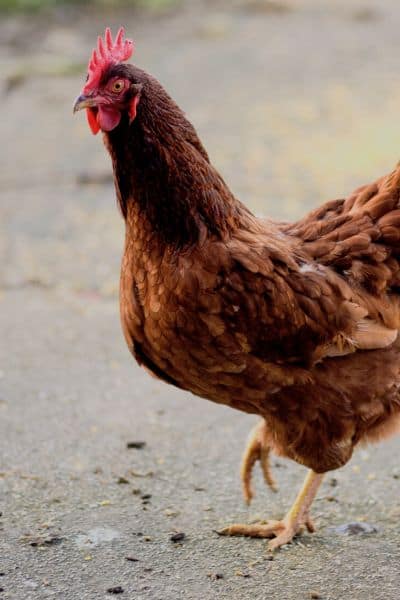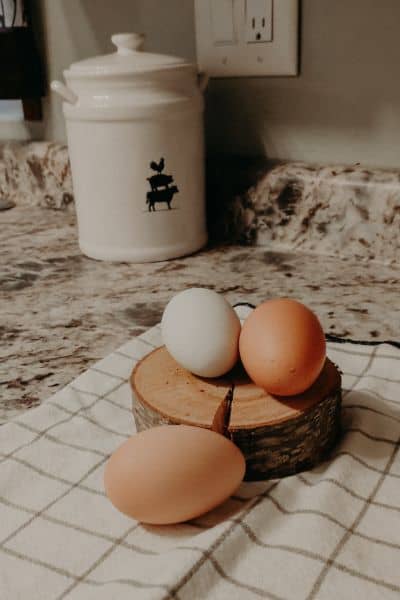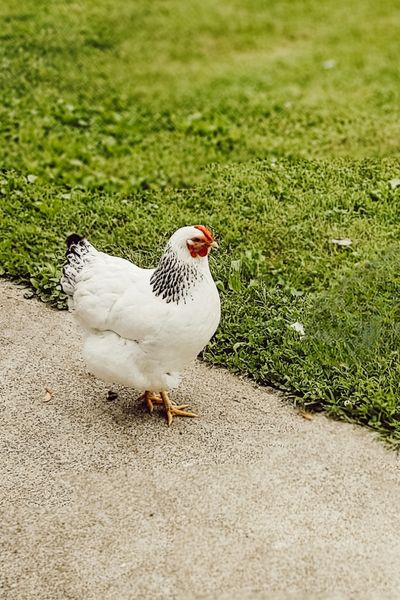Beginners Guide On How To Raise Meat Chickens Fast And Efficiently
Alright, y’all let’s talk about how to raise meat chickens. And by meat chickens I mean those big round ugly white birds called cornish rock cross, or cornish cross, or some variation of that.
Learning how to raise broilers can be a fun experience… buttttt….. you better be prepared for a few things first.
Meat chicks grow extremely fast, are very messy, and are not the nicest looking bird once they lose all their down. They are the pigs of the poultry species. I promise you I am not exaggerating. But the upside is you don’t have to deal with them for long if you want to supply your family with a fast-growing meat supply.
I was one of those 4Her’s who got their hands into every possible animal project her parents would let her do. And meat birds were no exception. While my 4-H years are FAR behind me I’m going to go over the tips I learned doing those projects and even some tips I got from the national poultry judges about how to grow the birds to production standards.
ppssttt Ex-4Her pro tip: Most counties have some kind of auction for the 4-H kids to sell their projects. If you are short on space and don’t want to be stuck with the project for a long period of time like beef cattle then a broiler project is your best route.

This post may contain affiliate links and if you choose to make a purchase through my links I may receive a commission at no extra cost to you.
What You Need To Know BEFORE You Get Into How To Raise Meat Chickens
- Meat chickens are NASTY. They smell worse. Poop more and are extremely clumsy.
- Their speed of growth is out of this world.
- They get large fast and when its hot out they need to be monitored for heat stroke.
The Cornish Cross was developed to be ready for market extremely fast. Depending on what percentage of protein is in the feed that you use. They can be ready to butcher as early as 6 or 7 weeks old. This speed is really tough though. 9 weeks should be the goal for a homesteader or someone raising them on their backyard farm.
If you have 5-10 birds they will only fit in tubs for maybe the first 5 to 6 days. After that, they will need something much larger like a kiddy pool. Or a large pen with about 2-3 square feet per bird. That way you don’t have to move them again until they are ready to butcher.
One option that worked well for us is asking your local grocer for one of those cardboard bins that watermelons or pumpkins come in. Then after the birds are gone you can just drag the mess out to the burn pile and light it up.
Chicken tractors are also an option to get your chickens outside for some time. But keep in mind that a chicken tractor is not predator-proof. You will need to make sure you close up your meat chickens at night. You are going to have to move it EVERY DAY if you don’t want that patch of grass to be completely destroyed.
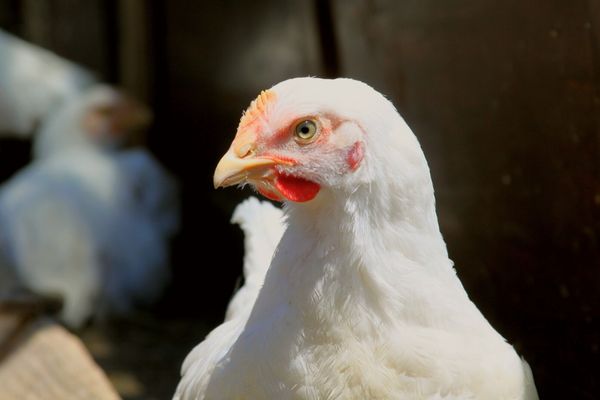
Is It Worth It To Raise Chickens For Meat
Just like any area of life, you should have a homestead budget and a budget or idea of how much each project should cost. When you feel like you are constantly “pouring money” into something that’s when you start to get stressed.
For meat birds, it depends on what brand or what type of grocery store you are CURRENTLY buying your chicken meat from. If you are buying it from whole foods or you are paying for high-end organic meat. Then yes it probably is worth raising your own chickens for meat.
But if you are like most people are buying the chicken with the lowest price tag. Then it can work out to be more or about the same to raise it yourself.

Do not match the expences of raising meat chickens against the higher-cost organic meat if that is not what you are ALREADY buying to justify raising anything on the homestead. Especially if you are trying to raise your own food to help with the budget.
The average meat bird will get you 6 pounds of weight after it is butchered assuming you got it to 9-10 pounds before butcher. Keep in mind there is still some bone in that amount.
Cost To Raise A Meat Chicken
- One meat chick = 4.20
- Total feed cost – 15 Pounds Of Feed (.62 per pound) = 9.30
- Butcher fee = $3-$5
TOTAL = At minimum it is going to cost you $16.50 for one chicken.
If your bird gets to be 6 pounds that cost 2.75 per pound. So it’s right on the edge of if it’s worth it.
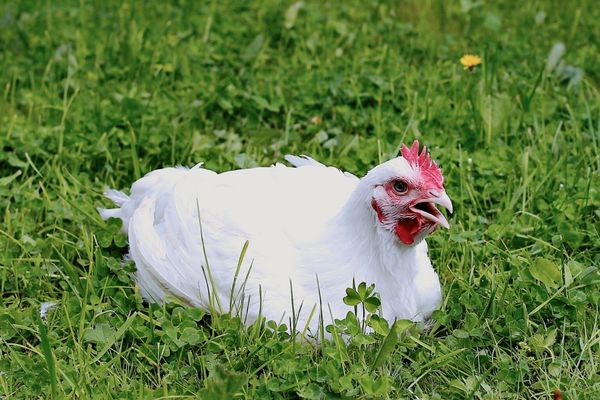
Dual Purpose Birds vs Broiler Chickens
Dual-purpose birds and broiler chickens are two different types of poultry commonly raised by backyard farmers.
But there are some BIG differences between them in terms of growth rates, meat quality, and suitability for meat and egg production.
Dual-purpose birds, as the name suggests, are bred to serve dual purposes – egg production and meat production. They typically have moderate growth rates and are known for their ability to lay a decent number of eggs while still having satisfactory meat yields. In terms of meat quality, dual-purpose birds have a good balance between tenderness and flavor. They are suitable for small-scale farmers who are looking to obtain eggs and meat from the same bird, reducing the need for separate flocks.
BUT they take two to three times as long as broilers to get to the size of butchering.
Broiler chickens are specifically bred for rapid growth and high meat yields. They have significantly faster growth rates compared to dual-purpose birds, resulting in larger chickens with more meat. The meat quality of broiler chickens is generally excellent, with high tenderness and minimal fat content. Because they are primarily raised for meat production, their egg-laying capacity is next to nothing.
If you are looking for versatility then a dual purpose is the way to go. But if you are looking for efficient meat production then broiler chickens are the best choice.
If you are struggling to know which way to go you need to set clear goals for your homestead. When you have intentional goals for your backyard farm it makes desition making so much easier. The Intentional Backyard Farm Strategy guide will help with that.
Free Farm Goal Planner!!!
➡️Get my proven system for choosing your farm goals so you don’t get burnt out.
Dual-Purpose Breeds
There are several breeds of meat chickens that some people recommend but here is the issue. Most of these are dual-purpose breeds or still grow much slower than cornish crosses and will cost you more in the long run. The meat is often not as tender and the birds need to be cooked a lot longer. Especially if they are heritage breeds.

These breeds are:
- Freedom Rangers
- New Hampshires
- Rhode island reds
- Red rangers
- Black Australorp
- Orpington
- Wyandotte
The Best Time Of Year To Raise Meat Birds Efficiently
This is something that will help you save on feed costs. Think about the time of year and the weather that comes with it. You do not want to be raising day-old chicks or meat birds in the cold weather. It will slow down weight gain big time.
The broilers don’t get a whole lot of feathers. Some will even have bare undersides. If the temps are anything less than 75 degrees Fahrenheit they are going to put energy into keeping warm.
They will be eating more feed and it will go straight to keeping warm. Not towards their growth. Cooling them down with fans was a trick we could use if our meat projects were going to be overweight close to the weigh-in day.
So make sure that the average day and night time temps stay above 70 to keep them from getting cold. Or you will just be wasting your efforts.
You can add a heat lamp with a heat bulb on a timer like these. If you are in a season of the year where the temps fluctuate drastically and your meat chickens need a heat source for part of the day but not the whole time the timer is a huge help.
Just make sure you pay close attention to them. You don’t want to accidentally forget to turn the heat off and the temps reach 75-80 degrees and the chickens get overheated and die. While they are sensitive to cool temps they also overheat easily because of their weight.
If they get too hot this will also slow down their food intake.

Meat Chicken Growing Tips
Here are some tips I have learned over the years that will help you with your bird’s growth.
Use A Light To Keep Them Eating Longer
The more light your broilers are exposed to the more they will stay awake and eat.
So if you want to take your cornish cross bird’s growth to the next level find a lamp you can turn on to extend the daylight hours for them up to 16-18hrs per day.
Make sure that if the temperatures are over 80 degrees you only use the light bulb you would use in your house NOT the heat lamp bulbs.
Firm Meat Not Fatty
Now here is a tip that I learned while showing in 4h. The cornish cross birds are judged on the firmness of the breast as well as their size. So to keep their meat from feeling and tasting “squishy” you can put their feed on raisers with ramps going up to the feed. This will help them get a little exercise and not burn too much of the feed.
Just make sure that the ramp is not slick because these birds are not as good at balancing as other chicken breeds. You do not want them to slip or fall off and break a leg which is totally possible.
If you are using these birds as a 4-H project then the last two weeks before the show switch the birds to a finisher feed.
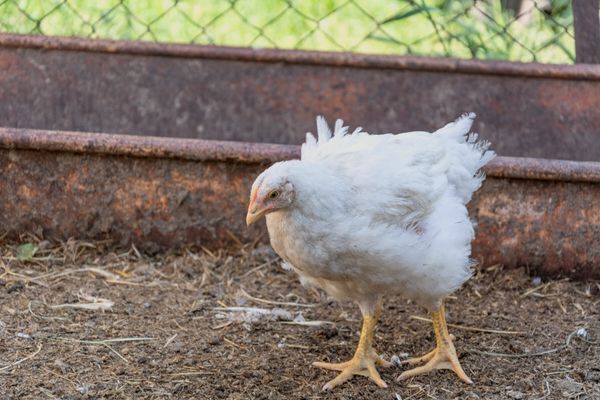
Where To Get Your Cornish Cross Meat Chicks
While most of the time I recommend getting them from a hatchery for multiple reasons which you can read about here.
Getting baby chicks for meat from a feed store is fine because they are not going to be around super long and you are wanting them to produce meat. Not egg production. So if the store gets the gender wrong you aren’t out a lot of money and most meat chickens come as straight run (not sexed) anyway.
Ideal Butcher Age
Once the birds hit 9 weeks their feed-to-meat conversions start to die off. So it is best to try and get them ready to butcher at or before 9 weeks. Which is the biggest reason for all of these speedy growth tips.
Lets do some math.
- It takes about 15 pounds of total high protein feed to get a broiler chicken to a butcher weight of 9 pounds.
- You raise them for 9 weeks, which equates to 63 days.
- 15 divided by 63 is 0.238 or one-quarter pound per day. Now obviously they will eat most of that in their last few weeks of life.
So how much will this cost you to raise them?
| Number of birds | Pounds Of Feed | How Many Bags Of Feed @ 50LBS | Cost Per Bag $24 | Total Cost + 7% Sales tax |
| 1 Meat Chicken | 15 pounds of feed | 3.33 of a bag (1/3rd) | $8 | $8.56 |
| 10 Meat Birds | 150 pounds of feed | 4 (You would need a smidge more than 3 bags | $96 | $102.72 |
| 15 Meat Birds | 225 pounds of feed | 5 bags | $120 | $128.40 |
| 25 Meat Birds | 375 pounds of feed | 8 bags | $192 | $205.44 |
Keep in mind this is assuming that you are following best practices and trying to keep the chickens from getting cold or scared and burning unnecessary food for other reasons besides growing.
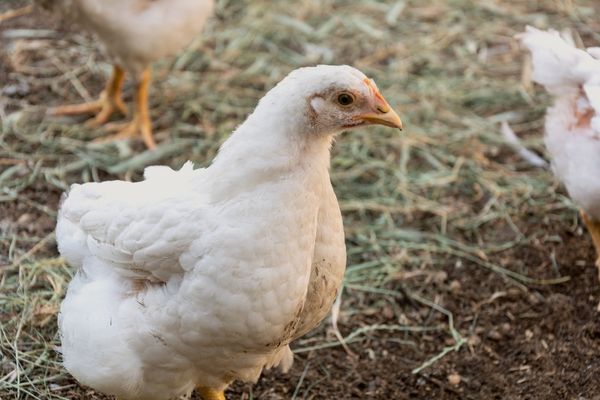
Basic Meat Bird Care
Here is the basic care you need to know to raise healthy meat chickens.
How And What To Feed Meat Chickens
The type of feed matters for fast growth you want to feed the highest percent of protein content you can get (above 25%) and they will grow very quickly. In some areas, you can find a feed that is more than 30% protein. The 5-8% difference in protein can mean the difference between you getting a 6-7 pound bird at butcher time or having a bird that weighs 9-10 pounds at the butcher.
Keeping clean water available at all times is a must. These birds drink a lot and need water to help stay cool in the really hot months.
As far as the feed availability, it is up to you if you want to just give the recommended amount or keep the feeder full and they can eat whenever they want.
The more you feed them the faster they will grow. But that also gets to be expensive. So you can feed them the recommended amount and whatever size they get to be is what they will butcher at but then you also run the risk of them being smaller.
The other thing I could recommend is to make sure that wild birds can’t get to where the feed is for the batch of meat chickens. The chicken feed will attract the wild birds and you will be feeding all the local sparrows as well as your meat chickens.
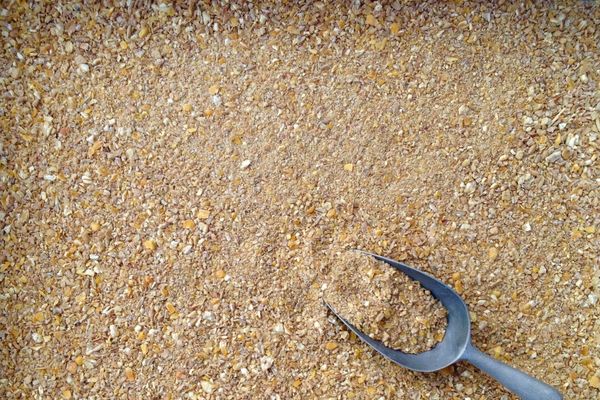
Three Things That Will Sound Good But Slow The Rate Of Growth
If you are trying to raise meat for your family effectively then all of these money-saving hacks and tips don’t really work out because sure they fill up the birds BUT they don’t grow as quickly.
Kitchen Scraps
Using alternative feed sources is ok once in a while but the more you feed them anything but high protein feed the slower they will grow because they only have so much room to eat. And if they are taking up room with kitchen scraps they will be eating less high-protein food..
Organic Feed
Organic feed is all well and good but the problem with that is most often it comes in an average of 25% protein. This will slow down the rate of growth but also cost you significantly more feed to grow the birds to weight.
Pasture Raised
Letting your birds’ free range to an extent is ok but you have to limit own far they can go. These birds are very large and if they get overheated and even have a heart attack. They will also be out raising on other things which is ok but then they are not taking the time to eat the high protein food you are providing.
This is one of those pick your battles kind of things. If you are growing chickens to simply have the experience of raising your own meat chickens then by all means do what you feel is best.
But if your goal is to be efficient. Then you need to cut the fluff and keep your birds focused on growing.

How Much Space Do Meat Chickens Need
Knowing how much space per bird to provide your birds is an important factor in their health and growth.
Chickens raised for meat usually reach butcher weight between 8-12 weeks depending on the breed, feed, and temperature. As a general rule of thumb, you will need roughly 2 square feet per bird in the brooder.
Providing ample space will help keep them from becoming stressed which can lead to poor growth or even cannibalism.
It’s important to provide enough space for your chicken’s well-being as well as provide enough room for feeders and water. You don’t have to worry about roosting because these hybrid chickens are not capable of roosting once they get to be large and top-heavy. It’s not worth the risk of them falling off and breaking a leg or their neck.
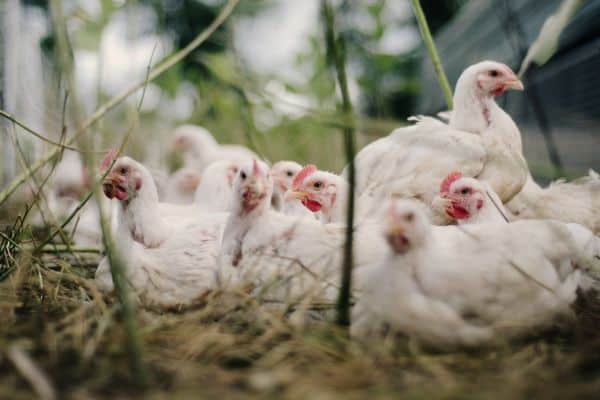
Pine Bedding for a Brooder: Essential for Comfort and Health
When it comes to raising chickens, making sure you have the proper bedding is more important than you realize. Bedding not only provides a comfortable surface for your chickens but also plays a vital role in maintaining their overall health and well-being. One of the most recommended bedding options for chicken coops is finely shaved pine wood chips.
The main advantage of wood chips is the absorbency. Chickens produce waste regularly, which can make their living space messy and potentially contribute to foul odors FAST. By using finely shaved wood chips as bedding, you can effectively absorb moisture and odor, making the brooder easier to clean and keeps them dry.
However, it is essential to monitor the cleanliness of the coop regularly. When the bedding appears dirty or messy, it’s time for replenishment.
Regularly replenishing the bedding in your chicken coop or brooder not only keeps it clean but also helps maintain better air quality.
Dirty bedding can harbor bacteria and pests, posing a risk to the health of your chickens.
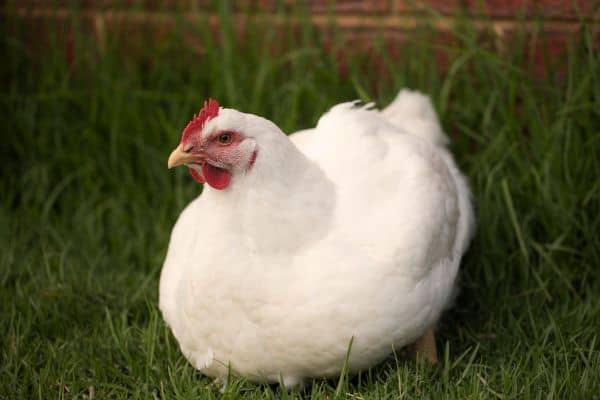
Temperature Requirements and Guidelines for Using Heat Lamps For Meat Chickens
When raising chicks, providing the right temperature is crucial for their health and well-being. Heat lamps are commonly used to create a warm and cozy environment in a brooder. Here are the temperature requirements and guidelines for using heat lamps to raise chicks:
During the first week of their lives, chicks require a warm and constant temperature of around 95°F (35°C) in the brooder. This initial temperature is vital for their growth and development.
As the chicks grow and develop feathers, the temperature can gradually be reduced by 5°F (2.7°C) each week. By the end of their fourth week, the chicks can tolerate room temperature, allowing the heat lamp to be removed entirely.
BUT like I mentioned earlier you do need to pay attention to the night time temperatures and how the chickens are behaving because if they get the slightest chill this will cause them to put their energy into staying warm and not growing.
So make sure to use some form of heat if needed to keep them from getting too cold once the sun goes down if you have them during the early spring.
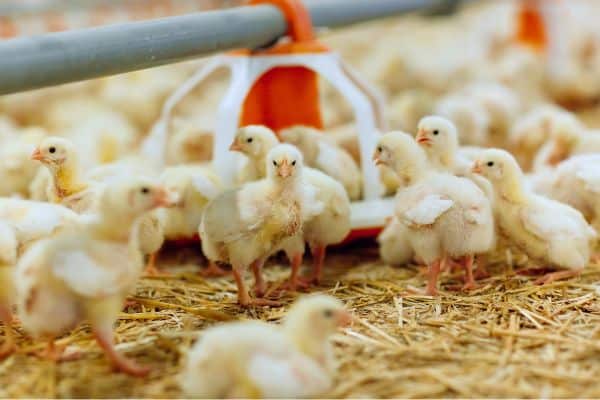
Factors Affecting Bird Health
Wind can cause drafts, which can make the brooder colder and even cause health issues for the chicks. It is essential to position the brooder in a way that minimizes wind and drafts.
Humidity is another crucial factor that can impact bird comfort. High humidity levels can result in dampness, leading to health problems for the chicks. Maintaining optimal humidity levels between 40-60% is recommended.
Outdoor access is not suitable for chicks under four weeks old. Exposure to outdoor elements such as extreme temperatures or predators can be detrimental to their health. It is crucial to keep the brooder and heat lamp indoors or in a barn until the chicks are older and adequately protected.
Feeders and waterers
When it comes to providing feeders and waterers for birds, it is important to consider their appropriate sizing and placement as well as make necessary adjustments as the birds grow.
Feeders should be selected based on the number of birds being raised and the type of feed being provided. It is crucial to ensure that the feeder is not too large, allowing feed to go stale, or too small, leading to constant refill requirements. The height and location of the feeder should be such that the birds can easily access the feed, while preventing the feed from being contaminated by droppings.
Hanging tube-type feeders are a popular choice for poultry rearing. These feeders can be easily adjusted in height, allowing them to be raised as the birds grow. Initially, the feeder should be set at a height level that is easily reachable by the smallest bird in the flock. As the birds grow taller, the feeder should be periodically adjusted to a comfortable height to prevent any unnecessary strain or injury.
In terms of waterers, automatic waterers can save a lot of labor and provide consistent access to fresh water for the birds. These waterers should be placed at an appropriate height, ensuring easy access by the birds. Like feeders, the waterers should be adjusted based on the birds’ growth to maintain their accessibility.
Overall, selecting the right size and placement of feeders and waterers is crucial for the well-being of the birds. Adjusting the height and utilizing hanging tube-type feeders and automatic waterers can ensure convenience and efficiency while rearing poultry.
Get help and find motivation as we build our intentional backyard farm together.
Tips To Prevent Health Issues Or Disease
Here are some practical tips and techniques to help prevent the most common health issues and diseases in broiler chickens.
Breast blisters
Breast blisters can affect poultry, especially broiler chickens. These blisters occur on the breast area around the keal bone and are characterized by the formation of reddened, swollen, and sometimes ulcerated patches of skin.
They are most commonly caused by pressure and friction from constant rubbing against rough or abrasive surfaces because the birds are so large once they reach about 6 weeks they start to do a lot more laying around.
If the brooder is staying too damp this can also cause breast blisters to show up.
The primary symptom of breast blisters is the appearance of blisters or sores on the breast area. These blisters can be painful, causing the bird to exhibit signs of discomfort. In severe cases, the blisters may become infected, leading to the formation of abscesses or ulcers. Birds with breast blisters may also show reduced feed intake, weight loss, and decreased activity levels.
- Treatment options for breast blisters in poultry include improving litter management.
- Keeping the litter clean and dry is crucial to prevent the occurrence of breast blisters. This can be achieved by regularly removing wet or soiled litter and providing proper ventilation in the poultry house.
- Overcrowding should be avoided as it increases the likelihood of birds rubbing against each other or abrasive surfaces.
Using equipment without sharp edges is also essential to minimize the risk of creating pressure points on the birds. Additionally, implementing feeding programs that promote good body structure can help reduce the occurrence of breast blisters by ensuring birds have balanced nutrition and appropriate body weight.
Cannibalism and picking
Cannibalism and feather picking are two behavioral problems commonly observed in poultry meat birds. These issues can be detrimental to the overall welfare and productivity of the flock.
Several factors contribute to the occurrence of cannibalism and feather picking, including crowding, nutrient deficiencies, poor ventilation, and inadequate drinking and eating space.
- Overcrowding is a significant cause of these behaviors. When birds are kept in close proximity, they may become stressed and exhibit aggressive behaviors towards each other, leading to cannibalism and feather picking.
- Nutrient deficiencies, particularly in protein and certain essential vitamins, can also trigger these behaviors. Birds lacking essential nutrients may engage in cannibalism and feather picking in an attempt to obtain these nutrients.
- Poor ventilation and inadequate drinking and eating space can also contribute to these behavioral problems.
To manage cannibalism and feather picking, it is crucial to implement good management practices. These include providing sufficient space and ventilation to reduce stress levels, ensuring a balanced diet rich in essential nutrients, and regular monitoring of the flock. Additionally, the use of pick-paste remedies can be helpful, especially for small flocks. These remedies are applied topically to the birds’ damaged feathers, discouraging further feather picking.
Other Common Questions About Meat Birds
Here are some other questions people have about meat chickens.
Can you keep meat birds with laying hens?
Raising chickens has become more popular in recent years, and for good reason! Not only are they a sustainable source of food. If you’re thinking about adding chickens to your farm or homestead and you are wondering if you can keep meat birds with laying hens?
The answer is yes and no. While there is no health reason why you can’t It depends on the stages of growth and there are going to be some disadvantages to keeping them together.
- Keeping meat chickens with laying hens while they are still chicks is not a good idea because almost every other breed of chicken grows so much slower than the meat chickens. And these meat chickens are VERY clumsy. The meat birds will just bump into your other chicks and cause internal damage. It’s not on purpose just how they are. You will lose more chickens than if you kept them separate.
- What if your laying hens are full grown? – This is going to be much less of an issue but the main drawback is your high-protein chick starter is going to cost quite a bit more than laying chicken feed. Depending on the number of hens you have you are going to be costing yourself a whole lot more un-nessicaraly. As well as you might run into issues with your meat birds not getting as much food because of the other chickens. Causing them to not make weight.
Do Meat Chickens Lay Eggs
Yes, they can! Buuuut, these birds often have health issues and lay WAY LESS often than egg-laying breeds. Like 50-100 eggs if you are lucky.
Meat chickens, or broiler chickens, are a special breed of chicken that is raised as food. These birds are bred to grow quickly and provide large amounts of meat for human consumption.
These fast-growing birds are not meant to live super long so having good strong bodies really isn’t a concern. The other issue with this breed laying eggs is they are developed to grow fast and produce meat. So you have to keep this breed slender if you want them to reproduce. Most often they are so large their legs give out on them after about 12-14 weeks old much less being capable of breeding.
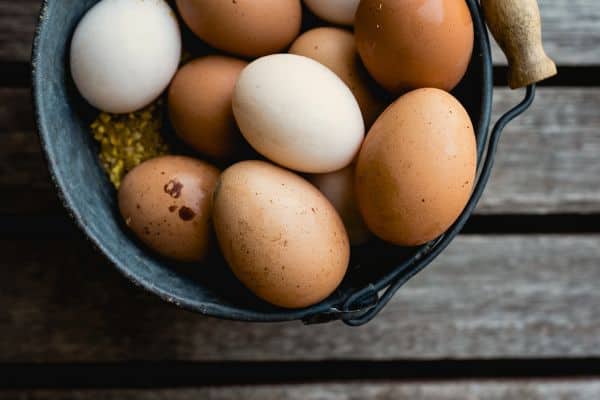
How Until You Can Harvest (butcher) Meat Chickens?
Ideally, you want to have your meat chickens ready to butcher at 9 weeks of age. But you can take up to 12 weeks. After that, it’s not worth it.
Raising meat birds is a great first project for 4h projects or even an easy and less time-consuming way to produce your own meat if you want to start doing that. You don’t have to care for the animals through the winter and after about two months of work you can have a lot of meat for your freezer.

If you want to raise meat chickens for your backyard farm but don’t have a clear plan of how many you need to raise or you aren’t sure if they really serve a purpose. The Intentional Backyard Farm Strategy guide will walk you through how to make a plan for your backyard farm and make sure you are building the life you want. Check it out here.
